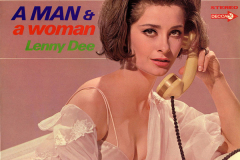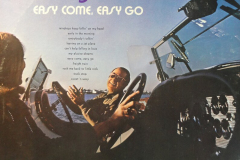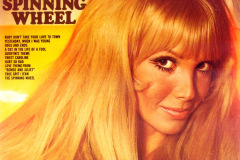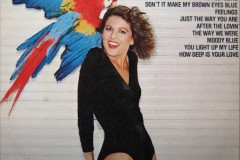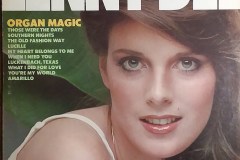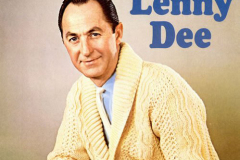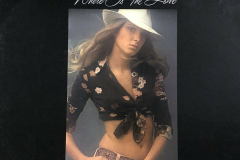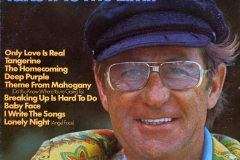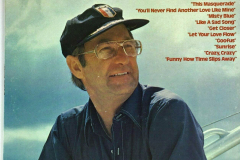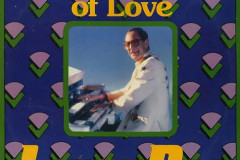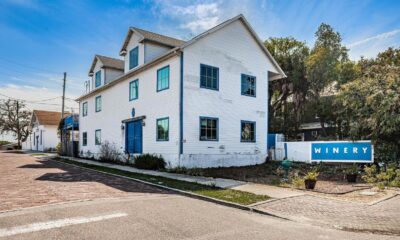Create
Vintage St. Pete: It’s Lenny Dee
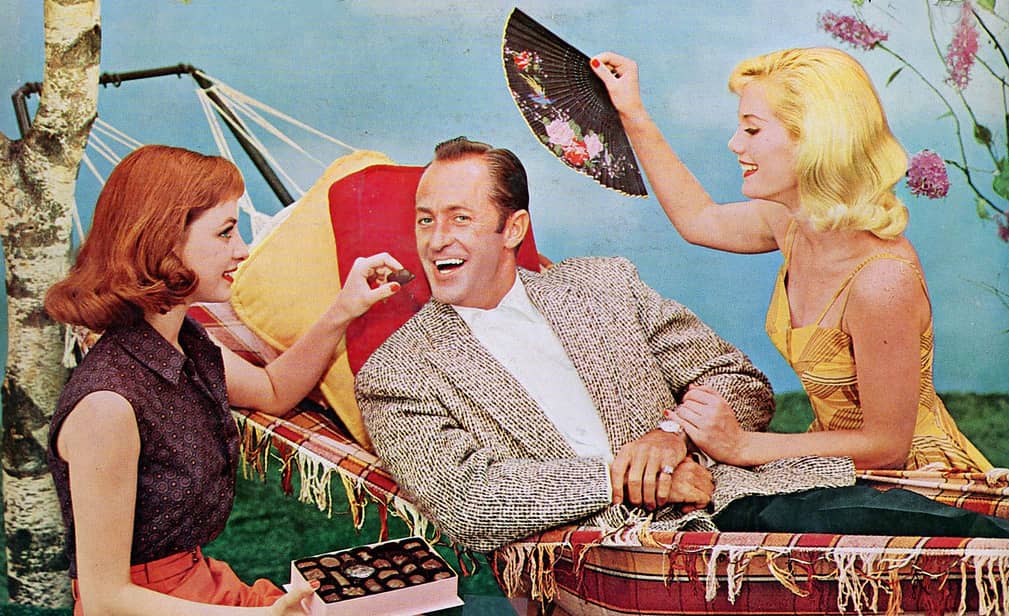
He mostly kept rock music at arm’s length, but Lenny Dee was St. Petersburg’s first – and to date only – real rockstar. During the period of his greatest success, the 1960s through the ‘80s, Dee was an internationally-renowned entertainer, averaging two albums per year on one of the biggest record labels in the world.
St. Pete, however, was home, and when he wasn’t on the road, touring or recording or appearing on some TV show, Lenny Dee was a devoted family man who ran a successful business on the beach.
The business was Lenny Dee’s Dolphin Den, a high-end nightclub and restaurant, and its chief product was Lenny Dee himself, for two shows per night. The Den was always packed with people dressed to the nines – it was strictly a coat-and-tie joint – who paid to catch the floor show.

Dee family photo.
Dee played the Hammond electric organ, and his act consisted of current easy-listening hits, alongside good old singalongs like “Toot-Toot Tootsie Goodbye” and “Has Anybody Seen My Gal?” These were presented along with an array of funny hats and accents, and a stream of corny and occasionally off-color jokes, told from his white organ bench beneath a large mirror that gave the audience a view of his hands as they deftly flew across the twin keyboards. He was, in a word, animated.
Perhaps it sounds quaint these days, when entertainment tends to scream for attention from all sides. But in a simpler time, a big St. Pete night on the town meant the dinner theaters, or the ornate Kapok Tree Inn, maybe dancing at the Coliseum … or a dinner date at Lenny Dee’s Dolphin Den.
Dee’s daughter Georgia idolized her old man. “He used to draw people from everywhere, because there was no Disney World, no theme parks in Florida,” she says. “St. Pete Beach was a destination location for entertainment.
“But if we went, for example, to St. Peter’s Cathedral in New York, the organist there recognized him the minute he walked in. People knew him – he’d say his name and they were like ‘Oh my gosh, you’re Lenny Dee!’”
Self-contained

1950s
He was born Leonard George DeStoppelaire, a Chicago kid whose uncle taught him to play the accordion. Following a Navy stint during World War II, he enrolled, on the G.I. Bill, at the Midwestern Conservatory.
It was there, in 1945, that he discovered the Hammond organ, which used a series of sliding drawbars to create different sounds – and therefore, different combinations of sounds, depending on which bars were pulled or pushed. In an era long before synthesizers, the Hammond could sound like other instruments. He learned the left-handed boogie-woogie. He learned to simultaneously work the bass pedals with his feet.
“After the war, a lot of guys were playing in lounges,” Dee recalled years later. “With an organ, you could self-contain yourself. You didn’t need other guys.”
In 1955 country music star Red Foley caught Dee’s one-man-band act at Nashville’s Plantation Inn, and recommended him to his label, Decca. With its World War II-era star organist Ethel Smith getting a bit long in the tooth, Decca signed Lenny Dee on the basis of his sprightly instrumental arrangements of dance favorites and pop hits, and his oversized personality.
His first album, Dee-Lightful!, yielded a Top 20 hit in a Dee original called “Plantation Boogie.” In his career, Dee would record 56 albums for Decca, and for the company that later absorbed it, MCA Records.
Click below to hear “Plantation Boogie.”

1960s
For more than a decade, he toured the country, picking up exclusive bookings in the nightclubs that could afford him. Even as rock ‘n’ roll swept America and the world, Dee’s music – tuneful, toe-tapping, easy on the ears and unlikely to stir any kind of controversy – appealed enormously to one gently aging generation after another.
He appeared on all the TV shows – Ed Sullivan. Jack Paar. Arthur Godfrey. Mike Douglas. Lawrence Welk introduced him as “Denny Lee, the famous Chinese organ player,” Dee used to say in his act.
Still, it was a grueling pace. “I got sick – exhaustion, nerves, hives,” he recalled to an interviewer. “Went down to 120 pounds. The road tours got to me, one week here, two weeks there, carrying our equipment, eating in bed, traveling by truck.” His first marriage crumbled in the midst of it.
In 1961, Dee met a Dutch beauty named Hendrica Koreman in a Ft. Lauderdale club. After they got married, they settled in Sarasota – he was a big draw at the prestigious Elbow Room club – and decided to make a more permanent home near Tampa Bay.
(As a youngster, Leonard George DeStoppelaire spent summers visiting his grandparents in the Sulphur Springs neighborhood of Tampa, so he had a fondness for the area.)

1967 (l-r): Raymond, Georgia, Lenny and Henny. Dee family photo.
Lenny and Henny (as they called each other) brought two children into the world – daughter Georgia and a son, Raymond – in the ‘60s, while Lenny was in semi-permanent residence at the Desert Ranch Inn on St. Petersburg Beach. He became part owner of the place and played there for six years.

1968
Lenny Dee’s Dolphin Den opened July 1, 1967, in the new Dolphin Village Shopping Center, He’d signed a 10-year lease with businessman W.W. Caruth, who was building the shopping center across Gulf Boulevard from his beach hotel, the Happy Dolphin Inn. “I’m going to make this into the west coast’s most exciting supper club,” Dee enthused to the St. Petersburg Times.
In advertisements for the 350-seat Den, he billed himself as Nation’s Top Organ Comic. And no one was about to claim otherwise.
“St. Pete Beach was just a two-lane highway,” recalls Georgia Dee. “There was the Don CeSar, and then it was just all beach until you got to the shopping center.”
The show always began with a dance combo – sometimes two – before Lenny would take the stage, accompanied by a drummer (for many years it was Lenny Dee, Jr., his son from that first marriage) and a reel-to-reel tape recorder containing sound effects and background musicians. Dee triggered the tapes from his organ bench.
He also pioneered the use of tape delay – what is today known as looping – to create comic moments, and to make it sound as if there was more than just a single musician (or vocalist) on the stage.
During a good month – usually during the winter season – the club averaged about 5,000 paying guests. Dee was netting a half million dollars annually.
A brief history of the Hammond organ

Dee onstage at his custom white Hammond Model A. Note the mirror, the accordion, the tape recorder and the rack of albums available for purchase. Photo: Hays Doughty.
Although Hammond organs had been around since the 1930s and ‘40s, first in churches – as a less-expensive substitute for the pipe organ – and then popularized by Ethel Smith and her “Tico” novelty pop records, the instrument became widely used in the ‘50s. Jazz keyboardist Jimmy Smith introduced blues notes, walking basslines and, in the context of a jazz combo, improvisation.
Smith’s organ of choice was the versatile and dramatic Hammond B3, also used to great effect by Gregg Allman on the early Allman Brothers Band albums.
Booker T. Jones had been the first to play rock ‘n’ roll on a Hammond (think the 1962 smash “Green Onions”). Steve Winwood, Jon Lord (of Deep Purple), Keith Emerson (of the Nice and Emerson, Lake & Palmer) and Rick Wakeman were among the rock artists to make immensely creative use of the instrument.
According to the manufacturer, there was (and is) virtually no difference between the Hammond B3 and the C3, but the B3 became the “go-to” for jazz, rock and R&B. Lenny Dee played a half dozen different models, including the B3.
The Hammond’s trademark vibrato effect was the result of a specialized revolving magnet and speaker – the Leslie – housed in a separate cabinet.
Reflecting on his early days in Nashville, “With an organ, man, there’s no way,” Dee said. “Organ was for a church or funeral home. I just kept playing that good rhythm. They kept me around because I could put people on the dance floor, playing whatever sounded good to me.
“I picked up a little comedy, a bit from this guy, and that guy. Just kept building.”
Click below to hear “Caravan”:
The man and the music
There was nothing funny about his recordings – he played the music straight – unless you counted the eye-catching covers. The mid ‘50s albums, with punning titles like Dee-Licious!, Dee-Latin and Mr. Dee Goes to Town, featured Lenny hamming it up, pulling faces or dressed in wacky clothes. For his 1961 Christmas album (Happy Holi-Dee), he wore a Santa costume, the family’s three miniature poodles on his lap.
 The kicker has to be the jacket photo of 1962’s Down South, the first album cut after he and Hendrica moved to St. Petersburg. Taken at Cypress Gardens, the tourist attraction near Winter Haven, it depicts Dee and his organ zipping along out on the lake, an outdoor motor attached to the back of his little platform. He’s in full showman mode, dressed in a loud red blazer, his hands poised at the keyboard.
The kicker has to be the jacket photo of 1962’s Down South, the first album cut after he and Hendrica moved to St. Petersburg. Taken at Cypress Gardens, the tourist attraction near Winter Haven, it depicts Dee and his organ zipping along out on the lake, an outdoor motor attached to the back of his little platform. He’s in full showman mode, dressed in a loud red blazer, his hands poised at the keyboard.
And he’s watching as a pretty girl on a waterski glides by. As if it were the most normal thing in the world.
Click below to hear “Georgia on My Mind”:
Dee’s records were strong enough sellers to keep him on the label for decades. He scored just one gold album – 1970’s Spinning Wheel – but he religiously made the journey to Bradley’s Barn recording studio in Nashville twice a year, each time to cut 11 new songs.

“Relaxin’,” 1967. This is the only album cover to feature Henny – Mrs. Dee.
That translated into two albums a year. In the ‘60s, he covered mostly middle-of-the-road favorites like “Red Roses For a Blue Lady,” “Born Free” and “I Left My Heart in San Francisco,” while the next decade focused on the Top 40 pop charts and adult contemporary hits such as “I Write the Songs,” “You Light Up My Life” and “What I Did For Love.”
All of his albums were produced by country music legend Owen Bradley (Patsy Cline, Loretta Lynn, Conway Twitty). Guitarists Les Paul and Chet Akins appeared on his ’50s records. By the late ’60s, Bradley was adding lush strings and background singers for what was known as the “countrypolitan” sound.
Georgia says her father was a great procrastinator. “Maybe a week or two before the album was supposed to be cut, he would start saying ‘I gotta play this song, I don’t know this song.’ He would listen to the record, of how they did the song, then he would just sit down and play it by ear. Then add his flair to it.
“He worked best under extreme pressure.”
 At home, Dee was a boat enthusiast (he proudly captained a 35-foot Hatteras Flying Dutchman with his name loudly painted on the side), and a licensed airplane pilot. There was, his daughter recalled, a dirt landing strip behind the Dolphin Village plaza. “We were always down at Albert Whitted,” she says. “We would fly little Cessnas out of there. He had so many friends, and out on the beach we would go on a helicopter ride with one of his friends.”
At home, Dee was a boat enthusiast (he proudly captained a 35-foot Hatteras Flying Dutchman with his name loudly painted on the side), and a licensed airplane pilot. There was, his daughter recalled, a dirt landing strip behind the Dolphin Village plaza. “We were always down at Albert Whitted,” she says. “We would fly little Cessnas out of there. He had so many friends, and out on the beach we would go on a helicopter ride with one of his friends.”
A devout Catholic, Dee played organ during services at St. John’s every Sunday. He was fond of the occasional round of weekend golf.
“He was pretty introverted at home,” explains Georgia Dee. “It depended on his moods. Sometimes we’d say ‘oh, Dad’s on a spending spree,’ and he would go out and come home with all kinds of stuff. Big stuff, too – a new car, or a whole bunch of motorcycles for my brother. Or ‘we’re going on a trip,’ and then off we’d go somewhere for a couple weeks.”
 Europe, South America, the Caribbean, every National Park in the U.S.A. – the Family DeStoppelaire took a lot of vacations. In California, they always got the VIP treatment at MCA-owned Universal Studios.
Europe, South America, the Caribbean, every National Park in the U.S.A. – the Family DeStoppelaire took a lot of vacations. In California, they always got the VIP treatment at MCA-owned Universal Studios.
“We had chores at home – my brother would have to wash the boat, or wash the RV, cut the grass … we were normal like that. At the restaurant, I was a cashier, a hostess, a salad girl, a busboy. We always had to work. My brother was in the kitchen as a chef. And we washed dishes. We did everything.” Both kids graduated from St. Pete Catholic High School.
At the Dolphin Den, Dee appeared six nights a week, two 75-minute shows a night, for 11 months every year. “He was a very good man,” says Georgia. “He had a real strong work ethic. And he never drank.”
In 1978, after the 10 years were up, he left the supper club – and opened another one, the Kings Inn, on Treasure Island (“Home of the One-Pound Pork Chop”).
Twenty years ago, places on the beach would be crowded till closing time. Today, midnight comes and you couldn’t get them to watch Jesus Christ ride a bicycle on Gulf Boulevard. Tourists, you see, they want to get some rest so they can walk on the beach at 7 a.m.
Lenny Dee/St. Petersburg Times, March 6, 1984
Changing times
MCA Records’ new boss pink-slipped every one of the label’s easy listening artists in the late 1970s. Time, it seemed, had caught up with Lenny Dee. For the first time in 30 years, he was without a record contract.
Was his music hopelessly out of step? Strictly squaresville?
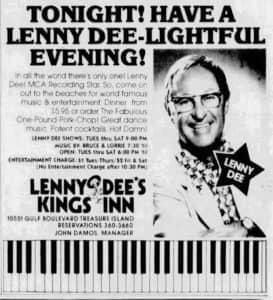
1980
In 1984, the remodeled Kings Inn became Georgy’s Supper Club, then Lenny Dee’s Supper Club. He announced his “semi-retirement,” especially from the grueling nightly club schedule. When the Kings Inn lease ended, he dissolved his business, Lenny Dee’s Dolphin Den, Inc. He moved to Tennessee and began making regular appearances on TV’s Nashville Now.
Two years later, however, he was back in town, doing weekends at the Anchorage, the former Tierra Verde home to Guy Lombardo’s long-ago Port-o-Call club.
The New Lenny Dee Show premiered at the Dolphin Beach Resort, three nights a week, in 1987. A move to the Coral Reef Resort happened in ’91. Friday and Saturday nights.
He was officially an institution now, and still playing weeknight one-nighters in the likes of Spring Hill, or Sarasota, or New Port Richey. Sometimes he did demo shows for the Hammond company. “They used to call me the Suncoast’s No. 1 son,” he’d tell the audience. “Now they call me the old son of a beach.”
In a 1997 interview with the Times, Dee bemoaned the lack of steady gigs and said he was selling a few of his beloved Hammond organs, dealing with arthritis and considering retirement. “I’m beginning to think God is telling me, Lenny, you’ve played long enough.”
 Still, he joked, “Better over the hill than under it.”
Still, he joked, “Better over the hill than under it.”
He smiled at the reporter. “I never forget I’ve been there, had it all. I never forget I’ve been on top.”
Nine years later, at age 83, he was gone.
Coda
Organist Mike Reed played the Hammond organ at the Bonfire Lounge, inside the Red Cavalier Restaurant in Redington Shores, for 13 years.
After Lenny Dee’s death on Feb. 12, 2006, Reed, wrote this online tribute:
“Two years ago when Lenny found out that he could no longer play the organ (which just killed his spirit) he called one day and said he was sending me a ‘care package.’ A week later I got a box from him filled with 20 cassettes of his old tapes and records. There’s stuff in there that I never heard him play, and they were from the very early days, about ’52 through ’55. There is even a demo which he and Louis Armstrong made in New York in 1954!
“I’ve got tons of pictures of him, especially back in ’64 when we first met (it was my high school graduation present to get to go hear him live).”
Reed, a retired music educator now living in Ohio, has a YouTube channel with dozens of videos of him playing “in the Lenny Dee style.” He calls Lenny The Master.
“My greatest possession is a picture of my opening night at the Cavalier, in 1977,” Reed wrote, “with my bosses, me, and Lenny Dee and Lenny Dee Jr., all gathered together in the lobby of the restaurant. That’s the kind of guy Lenny was … big enough to be there for those of us who idolized what he did with and for the Hammond organ.”


